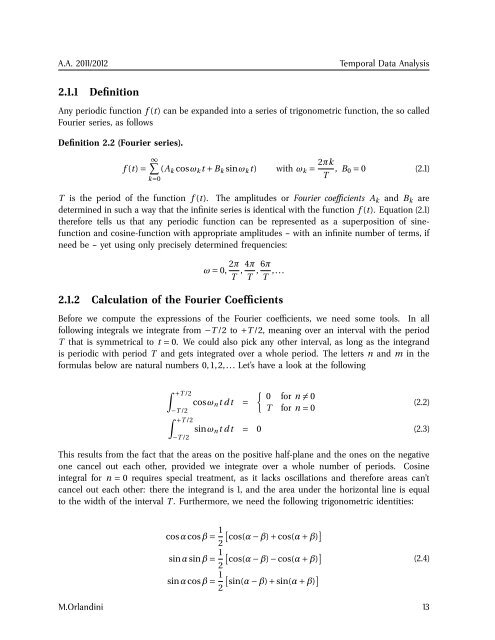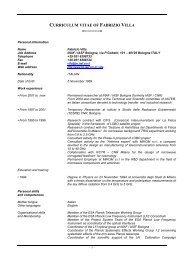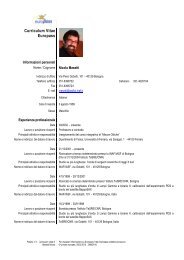booklet format - inaf iasf bologna
booklet format - inaf iasf bologna
booklet format - inaf iasf bologna
Create successful ePaper yourself
Turn your PDF publications into a flip-book with our unique Google optimized e-Paper software.
A.A. 2011/2012<br />
Temporal Data Analysis<br />
2.1.1 Definition<br />
Any periodic function f (t) can be expanded into a series of trigonometric function, the so called<br />
Fourier series, as follows<br />
Definition 2.2 (Fourier series).<br />
f (t) =<br />
∞∑<br />
(A k cosω k t + B k sinω k t) with ω k = 2πk<br />
T , B 0 = 0 (2.1)<br />
k=0<br />
T is the period of the function f (t). The amplitudes or Fourier coefficients A k and B k are<br />
determined in such a way that the infinite series is identical with the function f (t). Equation (2.1)<br />
therefore tells us that any periodic function can be represented as a superposition of sinefunction<br />
and cosine-function with appropriate amplitudes – with an infinite number of terms, if<br />
need be – yet using only precisely determined frequencies:<br />
ω = 0, 2π<br />
T , 4π<br />
T , 6π<br />
T ,...<br />
2.1.2 Calculation of the Fourier Coefficients<br />
Before we compute the expressions of the Fourier coefficients, we need some tools. In all<br />
following integrals we integrate from −T /2 to +T /2, meaning over an interval with the period<br />
T that is symmetrical to t = 0. We could also pick any other interval, as long as the integrand<br />
is periodic with period T and gets integrated over a whole period. The letters n and m in the<br />
formulas below are natural numbers 0,1,2,... Let’s have a look at the following<br />
∫ +T /2<br />
−T /2<br />
∫ +T /2<br />
−T /2<br />
cosω n t dt =<br />
{ 0 for n ≠ 0<br />
T for n = 0<br />
(2.2)<br />
sinω n t dt = 0 (2.3)<br />
This results from the fact that the areas on the positive half-plane and the ones on the negative<br />
one cancel out each other, provided we integrate over a whole number of periods. Cosine<br />
integral for n = 0 requires special treatment, as it lacks oscillations and therefore areas can’t<br />
cancel out each other: there the integrand is 1, and the area under the horizontal line is equal<br />
to the width of the interval T . Furthermore, we need the following trigonometric identities:<br />
cosαcosβ = 1 [ ]<br />
cos(α − β) + cos(α + β)<br />
2<br />
sinαsinβ = 1 [ ]<br />
cos(α − β) − cos(α + β)<br />
2<br />
sinαcosβ = 1 [ ]<br />
sin(α − β) + sin(α + β)<br />
2<br />
(2.4)<br />
M.Orlandini 13

















